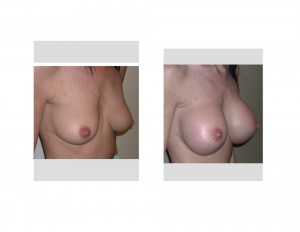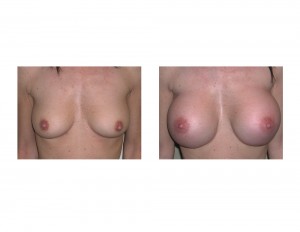Background: The size of breast implants selected for any woman’s breast augmentation is usually a hybrid between the patient’s desire and the surgeon’s recommendations. Many women are heavily focused on a natural look and fear looking like they have had their breasts ‘done’. They talk about being proportionate and having a new breast size that fits their body. Conversely some women, usually a smaller number, are more interested in a sizeable change in their breast size and prefer to have a more obviously augmented look.

It is not an exact science to determine what proper tissue support is. Feeling of the breast tissues helps determine how thick or thin it is and the amount of subcutaneous or breast tissue present. But there is no real way to determine the strength or integrity of the all important inframammary fold…the ligament that secures the bottom of the breast fold to the chest wall. It is this anatomic structure that plays a major long-term role in keeping breast implants in their desired position.
Case Study: This 28 year-old female wanted breast implants and did not fear having a breast size that was noticeably different. (large for her body frame) She was 5’ 2” and weighed 102 lbs. Her breast base width was 11.5 cms. She opted for saline implants placed through a transaxillary (armpit) incisional access.

When seen at one year after surgery, her breast implants were in a stable position. They were ‘large’ for her very thin body but the new inframammary fold positions were stable and no implant bottoming out was seen. Despite disrupting the inframammary fold (as is almost always necessary for most breast augmentations) the implant size did not cause loss of anatomic support.
Like every breast augmentation, one of the keys to good long-term implant position is not to make an implant pocket that is too large. An implant pocket that is just the size of the implant, properly positioned, is all that is needed. This is of particular importance in thin women who get larger sized breast implants.
Highlights:
1) Occasionally small women do request ‘large’ breast implants based on their small body frames.
2) As long as the breast implant base width does not significantly exceed the natural breast base diameter, the breast tissues should be able to support them.
3) Small incisional approaches that do not disrupt the inframammary fold helps provides long-term support to larger breast implants in women with minimal tissue support.
Dr. Barry Eppley
Indianapolis, Indiana



